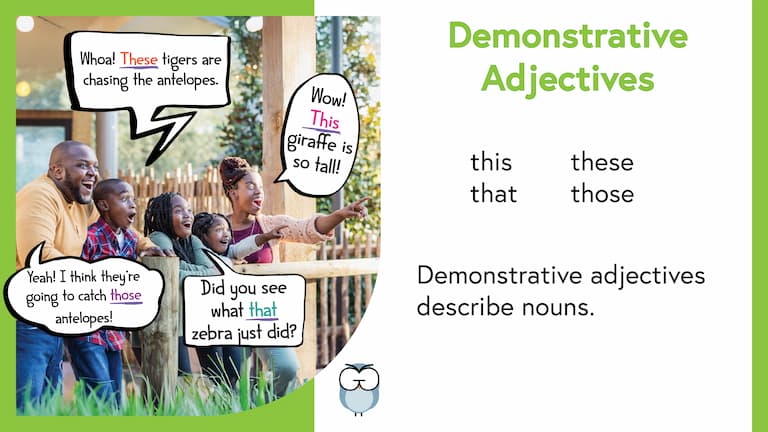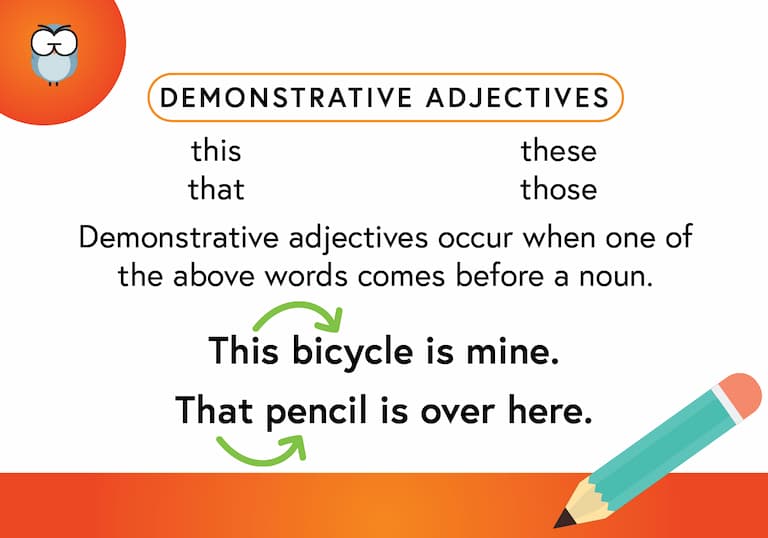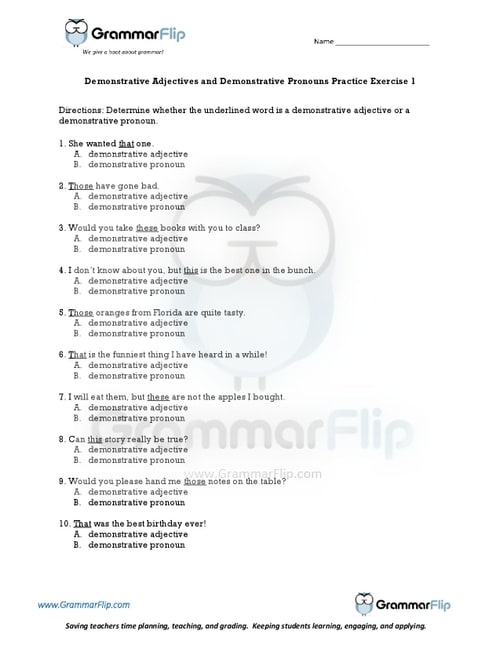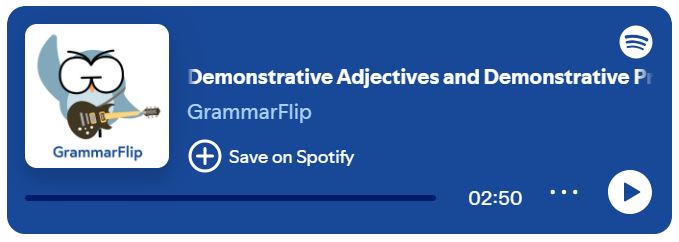What is a Demonstrative Adjective?
A demonstrative adjective can be one of four words: this, that, these, those. A demonstrative adjective occurs when one of the above words comes before a noun.
Some examples of demonstrative adjectives would be the following:
Have you read this book? (notice “this” is an adjective because it describes the noun “book”)
Please hand me that pencil. (notice “that” is an adjective because it describes the noun “pencil”)
Did you purchase these packs of gum? (notice “these” is an adjective because it describes the noun “packs”)
He wanted to bring those gifts to the party. (notice “those” is an adjective because it describes the noun “gifts”)
Long-Form Video: Demonstrative Adjectives
Long-form instructional video lessons allow students to engage with grammar concepts in more depth and detail.
This format provides students with a stronger foundation and a more comprehensive understanding of demonstrative adjectives.
Short-Form Video: Demonstrative Adjectives
Short-form videos are an excellent way to review grammar concepts. Our two-minute instructional videos help students review the concept of demonstrative adjectives to further solidify their understanding.
Memorable Image: Demonstrative Adjectives

The use of images to connect visual cues with concepts makes it simpler for students to grasp and remember key ideas. GrammarFlip’s memorable images create visual associations that make demonstrative adjectives more engaging and easier to retain.
Definition Cards: Demonstrative Adjectives
Definition cards reinforce grammar concepts by providing clear and concise explanations that students can easily reference for quick review and better retention. GrammarFlip’s definintion cards help students review the concept of demonstrative adjectives to further solidify their understanding.

Music: Demonstrative Adjectives
Learn grammar concepts through music! The unique verses and catchy chorus in our “Demonstrative Adjectives and Demonstrative Pronouns Song” will help your students further understand demonstrative adjectives. Listen for yourself and see if you don’t walk away singing this song to yourself!
Listen to GrammarFlip Music via Spotify, Apple, or Amazon!
Music Videos: Demonstrative Adjectives
Music videos make grammar concepts more engaging and memorable by combining rhythm, visuals, and repetition to reinforce learning. GrammarFlip’s music videos help students retain the concept of demonstrative adjectives more effectively while making the learning process fun and interactive.
Why You Should Use Demonstrative Adjectives in Your Writing
Demonstrative adjectives are an important part of your writer’s toolbox in that they can provide both emphasis and clarification.
We are not taking that bus; we are taking this bus.
These fingerprints were the ones found at the scene of the crime – not those fingerprints.
Many times, demonstrative adjectives seem to naturally occur in our writing without even thinking about them (which is great!), and when you use them intentionally, you can see just how powerful they are! Be sure you know the difference between demonstrative adjectives and demonstrative pronouns; they’re the exact same words, but they function differently in a sentence.
Download a Free Worksheet on Demonstrative Adjectives!
Click the image below to download your free worksheet on demonstrative adjectives!

Need a grammar program that provides the instruction and grading for you?
Explore More GrammarFlip Lessons!
Parts of Speech lessons provide the building blocks of grammar. GrammarFlip covers these topics in detail to ensure a solid foundation is built. First time learners and students seeking to review the parts of speech can both benefit from the instructional videos and slide show reviews.
Parts of the Sentence lessons are critical for understanding how the parts of speech function in language construction. From the basic to the advanced, these lessons will cover a wide range of grammar topics that can be used in any grade level or classroom.
Mechanics and Usage lessons equip students with the necessary skills to communicate clearly to all audiences. With a focus on the application of these concepts in student writing, these lessons tie together both simple constructions of grammar as well as the more complex such that any age or skill level of student will benefit.



